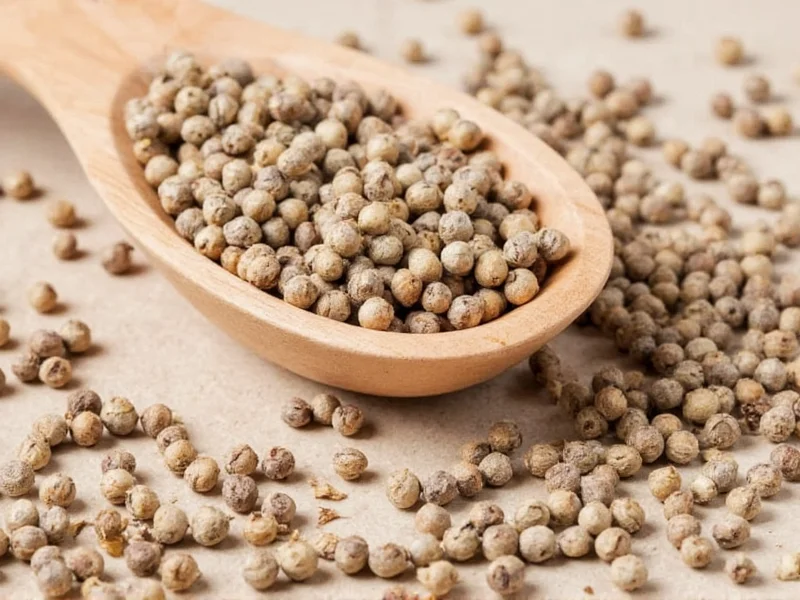Understanding the subtle yet significant differences between white and black pepper goes beyond mere culinary curiosity—it's essential knowledge for anyone serious about flavor development in cooking. The distinctive taste of white pepper results from a unique processing method that removes the outer fruit layer (pericarp) before drying, which alters its chemical composition and flavor profile compared to black pepper.
The Processing Difference That Creates Flavor Variation
Both white and black pepper originate from the same flowering vine, Piper nigrum, native to South India. The critical distinction lies in how the peppercorns are processed after harvesting:
- Black pepper: Made from unripe green berries that are cooked briefly in hot water and then sun-dried. During drying, the outer layer turns black and wrinkled through enzymatic oxidation.
- White pepper: Produced from ripe red berries with the outer skin removed through soaking (retting) in water for about a week, followed by rubbing off the skin before drying the remaining seed.
This processing difference significantly impacts the flavor compounds present in each variety. Black pepper retains more of the outer fruit layer containing essential oils like pinene, sabinene, and limonene, which contribute to its complex aroma and sharper bite. White pepper, with the outer layer removed, has higher concentrations of certain piperine compounds but lacks many of the volatile oils found in black pepper.
| Characteristic | White Pepper | Black Pepper |
|---|---|---|
| Processing Method | Ripe berries soaked to remove outer skin before drying | Unripe berries dried with outer skin intact |
| Flavor Profile | Earthy, musty, slightly fermented, milder heat | Sharp, complex, floral notes, stronger heat |
| Heat Level | Milder (approximately 20-30% less pungent) | More pungent with sharper heat |
| Common Culinary Uses | Light-colored sauces, mashed potatoes, cream soups, Chinese cuisine | Most savory dishes, marinades, rubs, general seasoning |
| Key Chemical Compounds | Higher piperine concentration, fewer volatile oils | More diverse essential oils (pinene, limonene, sabinene) |
Chemical Composition and Flavor Science
The distinctive taste difference between white and black pepper can be scientifically explained through their varying chemical compositions. Both contain piperine, the compound responsible for pepper's characteristic heat, but in different concentrations and alongside different supporting compounds.
Research published in the Journal of Agricultural and Food Chemistry shows that white pepper contains approximately 4-5% piperine compared to black pepper's 5-9%. However, the absence of the fruit layer in white pepper means it lacks many of the volatile aromatic compounds present in black pepper. This results in white pepper having a more one-dimensional heat profile compared to black pepper's complex flavor notes that include floral, woody, and citrus elements.
The retting process used to create white pepper also introduces subtle fermentation notes. During the soaking period, natural fermentation occurs, developing compounds like geosmin that contribute to white pepper's characteristic earthy, sometimes musty flavor—qualities that some professional chefs describe as "barnyard" notes.
Culinary Applications and When to Choose White Pepper
Understanding the taste difference between white and black pepper is crucial for making informed seasoning decisions in cooking. Professional chefs select between these varieties based on specific culinary requirements:
- Visual considerations: White pepper's pale color makes it ideal for light-colored dishes like béchamel sauce, mashed potatoes, or white fish preparations where black specks would be visually unappealing
- Flavor integration: White pepper's milder, earthier profile blends more seamlessly into delicate sauces and soups without dominating other flavors
- Regional cuisine requirements: Many traditional Chinese and Vietnamese dishes specifically call for white pepper due to its distinctive flavor profile that complements Asian ingredients
- Heat control: When a recipe requires pepper's warmth without its sharper bite, white pepper provides a more subtle seasoning option
It's worth noting that high-quality white pepper from specific regions like Tellicherry or Muntok offers superior flavor with less of the musty notes sometimes associated with inferior varieties. Proper storage in airtight containers away from light preserves the delicate flavor compounds in both pepper varieties.
Common Misconceptions About White Pepper
Several myths persist about white pepper that deserve clarification based on culinary science:
- "White pepper is just bleached black pepper" - False. While some low-quality products might use chemical bleaching, authentic white pepper is created through the natural retting process described earlier
- "White pepper is milder because it's older" - Incorrect. The milder heat results from processing, not age. Freshly processed white pepper still has less intense heat than black pepper
- "White pepper has no real culinary purpose" - This overlooks white pepper's specific applications in professional cooking where visual presentation and subtle flavor integration matter
Practical Tips for Using White Pepper Effectively
To maximize white pepper's unique flavor profile in your cooking:
- Grind white pepper fresh just before use, as its volatile compounds dissipate more quickly than black pepper's
- Use white pepper in dishes with dairy components, where its earthy notes complement milk proteins
- When substituting white for black pepper, increase the quantity by about 25% to achieve comparable heat levels
- Pair white pepper with ingredients like mushrooms, truffles, or shellfish that complement its earthy characteristics
- Store white pepper in a cool, dark place in an airtight container to preserve its delicate flavor profile











 浙公网安备
33010002000092号
浙公网安备
33010002000092号 浙B2-20120091-4
浙B2-20120091-4